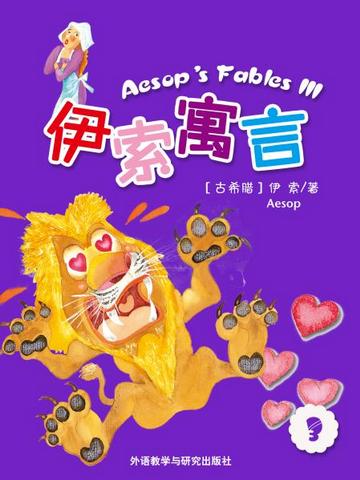一本经典名著就像一棵糖果树,更像一株向日葵,经过岁月长河的淘洗和沉淀,变为永恒的化石。但这种化石会呼吸、会眨眼,它们是有血有肉的精灵,焕发着迷人的光芒。名著,亦是成长的阶梯,通向梦想的天堂。从远古的回顾到今天的眺望,如果只选择停留在原点,便永远望不见地平线另一端的模样。成长,是一个过程,如果不能让脚步飞扬,那么就该让思想插上翅膀。童话与故事赐予我们想象,它们是基石,垫高我们迈向前方的脚。当我们把“为什么”变成惊叹号,当我们无畏地闯入大自然的怀抱,成长的轨迹便会向未来伸展成有力的形状。
《伊索寓言》是世界上最古老、最伟大的寓言集,被誉为西方寓言的始祖,它是世界上拥有读者最多的文学作品之一,对人类文化,尤其是西方伦理道德、政治思想影响深远,堪称人类文明史上的一座丰碑。书中的故事篇幅短小,寓意深刻,处处闪耀着智慧的光芒。柏拉图、亚里士多德、马克思等历代哲学家、思想家、政治家十分推崇此书。同时,此书也常常成为家庭教育的最佳教材和生活教科书。其中的经典名篇《龟兔赛跑》、《狐狸和葡萄》等在我国家喻户晓,还被编选入学生课本。
Aesop's Fables is said to be written by Aesop, an ancient Greek fable writer. It is said that he was a slave, who later got free and had since led an ordinary life. Aesop is a very wise man, which is illustrated by the several hundreds of fables fathered upon him handed down to this day. These tales tell us how to tell between friends and enemies, truths and lies. It also teaches people principles of dealing with people and handling affairs, and how to avoid potential danger by being careful and alert. This is a philosophical book of wisdom and also a practical textbook of living.
Some pieces in Aesop's Fables takes real people as characters. Other than that, they are mostly animal stories, which are featured by the personification of animals. The personification of animals comes from empirical observations of life and behavior of animals.
《伊索寓言》是一部寓言故事集。相传伊索是公元前6世纪古希腊人,善于讲动物故事。现存的《伊索寓言》,是古希腊、古罗马时代流传下来的故事,经后人汇集,统归在伊索名下。《伊索寓言》通过简短的小寓言故事来体现日常生活中那些不为我们察觉的真理。伊索寓言大多是动物故事,以动物为喻,教人处世和做人的道理。这些小故事主要是受欺凌的下层平民和奴隶的斗争经验与生活教训的总结。寓言通过描写动物之间的关系来表现当时的社会关系,主要是压迫者和被压迫者之间的不平等关系。寓言作者谴责当时社会上人压迫人的现象,号召受欺凌的人团结起来与恶人进行斗争。
Aesop's Fables is a collection of fables. Aesop probably lived in the middle part of the sixth century BC. He is said to be a quite skillful storyteller. The existing Aesop's Fables is a compilation of stories of ancient Rome and Greek by posterity under the name of Aesop. Aesop's Fables gives insight into the truths which are easily ignored in our daily life through short fables. Aesop's Fables are mostly animal stories. Using animal metaphor, Aesop's Fables teaches people principles of dealing with people and handling affairs. These short tales are mostly experiences and lessons drawn from life and struggle of the lower classes and slaves. The description of relationships between animals is very revealing about human relations, especially inequality between oppressors and the oppressed. The originator of the fables condemned the phenomenon of the exploitation of man by man, appealing to the united struggles of the people.
《伊索寓言》的文字精炼,故事生动,充满了丰富的想象力,是一部富有哲理的智慧之书。篇幅都不长,也不拘泥于形式,于浅显的小故事中揭露大智慧。它是少年儿童的启蒙教材,让他们了解什么是善恶美丑,它同时也是一本生活教材,对世世代代都产生了深刻影响。
《伊索寓言》大可看得。它至少给予我们三种安慰。第一,这是一本古代的书,读了可以增进我们对于现代文明的骄傲。第二,它是一本小孩子读物,看了愈觉得我们是成人了,已超出那些幼稚的见解。第三呢,这部书差不多都是讲禽兽的,从禽兽变到人,你看这中间需要多少进化历程! ——钱锺书
《伊索寓言》通过简短的小寓言故事来体现日常生活中那些不为我们察觉的真理,这些小故事各具魅力,言简意赅,平易近人。不但读者众多,在文学史上也具有重大影响。作家、诗人、哲学家、平常百姓都从中得到过启发和乐趣。许多故事真可以说是家喻户晓,如“龟兔赛跑”“狼来了”等等。在几千年后的今天,《伊索寓言》已成为西方寓言文学的范本,也是世界上流传最广的经典作品之一。
伊索被誉为“希腊寓言之父”,“西方寓言的开山鼻祖”。
伊索寓言是世界上最古老、影响最大的寓言。
Apollonius of Tyana, a 1st century AD philosopher, is recorded as having said about Aesop:
...like those who dine well off the plainest dishes, he made use of humble incidents to teach great truths, and after serving up a story he adds to it the advice to do a thing or not to do it. Then, too, he was really more attached to truth than the poets are; for the latter do violence to their own stories in order to make them probable; but he by announcing a story which everyone knows not to be true, told the truth by the very fact that he did not claim to be relating real events. —Philostratus, Life of Apollonius of Tyana, Book V: 14
Socrates is said to have spent some of his time in jail versifying Aesop's fables.
- 狮子、熊和狐狸
- 母鹿和狮子
- 农夫和狐狸
- 海鸥和鸢
- 哲学家、蚂蚁和墨丘利
- 老鼠和公牛
- 狮子和野兔
- 农夫和老鹰
- 墨丘利神木像和木匠
- 公牛和山羊
- 跳舞的猴子们
- 狐狸和豹
- 小猴子和他们的妈妈
- 橡树和朱庇特
- 野兔和猎狗
- 旅行者和命运女神
- 秃头骑士
- 牧羊人和狗
- 油灯
- 狮子、狐狸和驴
- 公牛、母狮子和野猪猎手
- 橡树和伐木工们
- 母鸡和金蛋
- 驴和青蛙
- 乌鸦和渡鸦
- 树林和斧子
- 螃蟹和狐狸
- 青蛙对太阳的抱怨
- 好事和坏事
- 妇人和她的母鸡
- 驴和老牧羊人
- 风筝和天鹅
- 狼和牧羊犬
- 野兔和狐狸
- 弓箭手和狮子
- 骆驼
- 黄蜂和蛇
- 狗和野兔
- 公牛和小牛
- 牡鹿、狼和羊
- 孔雀和仙鹤
- 狐狸和刺猬
- 鹰、猫和野母猪
- 小偷和旅店老板
- 骡子
- 公鹿和藤蔓
- 蛇和鹰
- 乌鸦和水罐
- 两只青蛙
- 狼和狐狸
- The Lion, the Bear, and the Fox
- The Doe and the Lion
- The Farmer and the Fox
- The Seagull and the Kite
- The Philosopher, the Ants, and Mercury
- The Mouse and the Bull
- The Lion and the Hare
- The Peasant and the Eagle
- The Image of Mercury and the Carpenter
- The Bull and the Goat
- The Dancing Monkeys
- The Fox and the Leopard
- The Monkeys and Their Mother
- The Oaks and Jupiter
- The Hare and the Hound
- The Traveler and Fortune
- The Bald Knight
- The Shepherd and the Dog
- The Lamp
- The Lion, the Fox, and the Ass
- The Bull, the Lioness, and the Wild-Boar Hunter
- The Oak and the Woodcutters
- The Hen and the Golden Eggs
- The Ass and the Frogs
- The Crow and the Raven
- The Trees and the Axe
- The Crab and the Fox
- The Frogs’ Complaint Against the Sun
- The Goods and the Ills
- The Woman and Her Hen
- The Ass and the Old Shepherd
- The Kites and the Swans
- The Wolves and the Sheepdogs
- The Hares and the Foxes
- The Bowman and Lion
- The Camel
- The Wasp and the Snake
- The Dog and the Hare
- The Bull and the Calf
- The Stag, the Wolf, and the Sheep
- The Peacock and the Crane
- The Fox and the Hedgehog
- The Eagle, the Cat, and the Wild Sow
- The Thief and the Innkeeper
- The Mule
- The Hart and the Vine
- The Serpent and the Eagle
- The Crow and the Pitcher
- The Two Frogs
- The Wolf and the Fox
- 书评 写书评
- 笔记
-
书评加载中...





















 京公网安备 11010802032529号
京公网安备 11010802032529号
笔记加载中...